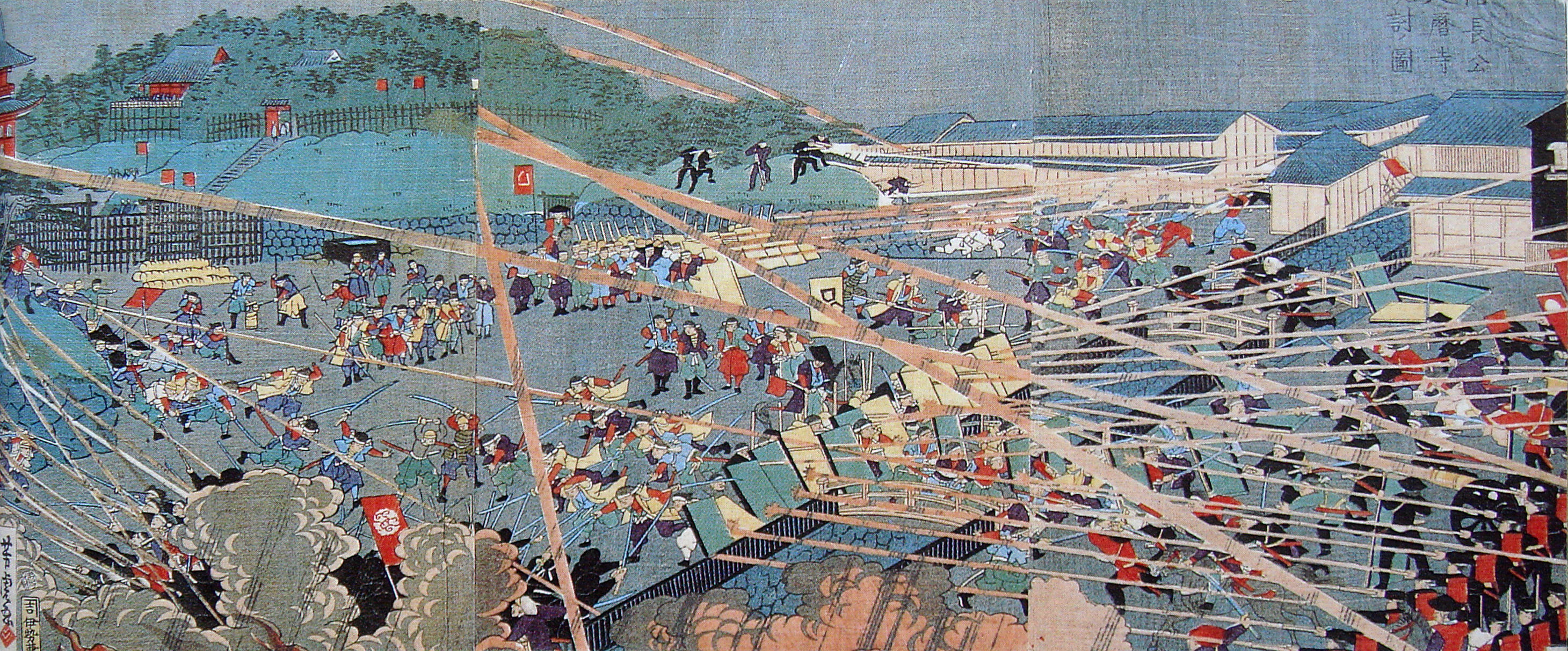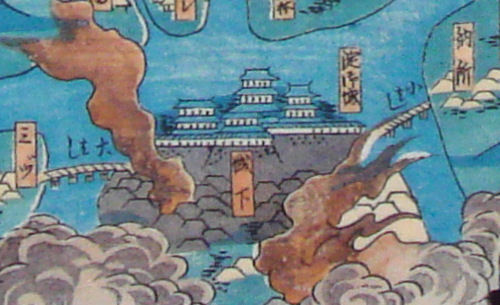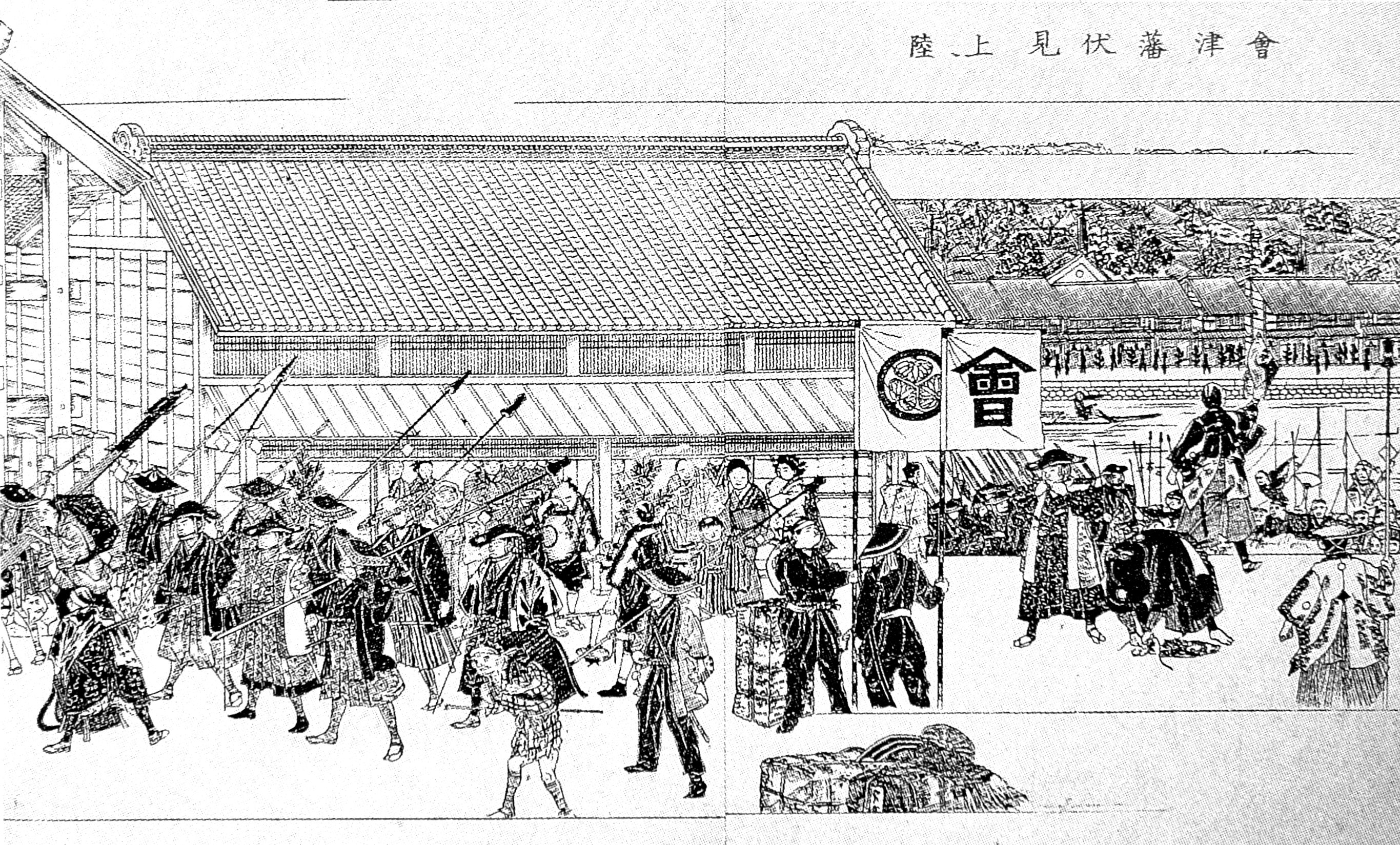|
Boshin War
The , sometimes known as the Japanese Revolution or Japanese Civil War, was a civil war in Japan fought from 1868 to 1869 between forces of the ruling Tokugawa shogunate and a clique seeking to seize political power in the name of the Imperial Court. The war stemmed from dissatisfaction among many nobles and young samurai with the shogunate's handling of foreigners following the opening of Japan during the prior decade. Increasing Western influence in the economy led to a decline similar to that of other Asian countries at the time. An alliance of western samurai, particularly the domains of Chōshū, Satsuma, and Tosa, and court officials secured control of the Imperial Court and influenced the young Emperor Meiji. Tokugawa Yoshinobu, the sitting ''shōgun'', realizing the futility of his situation, abdicated and handed over political power to the emperor. Yoshinobu had hoped that by doing this the House of Tokugawa could be preserved and participate in the future gover ... [...More Info...] [...Related Items...] OR: [Wikipedia] [Google] [Baidu] |
Battle Of Ueno
The was a battle of the Boshin War, which occurred on July 4, 1868 (''Meiji 1, 15th day of the 5th month''), between the troops of the Shōgitai under Shibusawa Seiichirō and Amano Hachirō, and Imperial "Kangun" troops. Prelude Though the Shōgitai was mostly made up of former Tokugawa retainers and residents of the surrounding provinces, some domains supported the Shōgitai, such as Takada ''han'' (Echigo Province, 150,000 ''koku''), Obama ''han'' (Wakasa Province, 103,000 ''koku''), Takasaki ''han'' (Kōzuke Province, 52,000 ''koku''), and Yūki ''han'' (Shimosa Province, 18,000 ''koku''). Facing them were the combined forces of the Chōshū, Ōmura, Sadowara, Hizen, Chikugo, Owari, Bizen, Tsu, Inaba, and Higo domains, under the general command of Chōshū's Ōmura Masujirō. Shibusawa and Amano initially had the 2000-strong Shōgitai posted in Ueno to protect Tokugawa Yoshinobu, who was, at the time, in self-imposed confinement at Ueno's Kan'ei-ji Temple, as ... [...More Info...] [...Related Items...] OR: [Wikipedia] [Google] [Baidu] |
Yodo Domain
The was a Japanese domain of the Edo period, and the only domain located in Yamashiro Province. Its castle was located within modern-day Fushimi, Kyoto. The strategic location of the castle figured in the 1582 Battle of Yamazaki. During the 1868 Battle of Toba–Fushimi, the master of Yodo changed his allegiance from the Shogunate to Imperial forces, going as far as closing his gate and refusing protection to the retreating army of the ''shōgun'' Tokugawa Yoshinobu. List of lords * Matsudaira (Hisamatsu) clan ( Shinpan; 35,000 koku) #Sadatsuna *Nagai clan ( Fudai; 100,000→736,000 koku) # Naomasa #Naoyuki *Ishikawa clan ( Fudai; 60,000 koku) #Noriyuki #Yoshitaka #Fusayoshi * Matsudaira (Toda) clan ( Fudai; 60,000 koku) #Mitsuhiro #Mitsuchika * Matsudaira (Ogyū) clan ( Fudai; 60,00 koku) #Norisato *Inaba clan ( Fudai; 102,000 koku The is a Chinese-based Japanese unit of volume. 1 koku is equivalent to 10 or approximately , or about . It converts, in turn, to ... [...More Info...] [...Related Items...] OR: [Wikipedia] [Google] [Baidu] |
Prince Komatsu Akihito
was a Japanese career officer in the Imperial Japanese Army, who was a member of the Fushimi-no-miya, one of the ''shinnōke'' branches of the Imperial Family of Japan, which were eligible to succeed to the Chrysanthemum Throne. Biography Early life Prince Akihito was born as Prince Yoshiaki, the seventh son of Prince Fushimi Kuniie. In 1858, he was adopted by Emperor Ninkō as a potential heir to the throne. As he was born when the country was still under rule by the Tokugawa Bakufu, he was sent into the Buddhist priesthood, and assigned to serve at the ''monzeki'' temple of Ninna-ji in Kyoto, where he adopted the title ''Ninnaji-no-miya Yoshiaki'' (仁和寺宮嘉彰). He returned to secular life in 1867 during the Meiji Restoration, and led imperial forces to Osaka, Yamato, Shikoku and Aizu during the Boshin War to overthrow the Tokugawa shogunate. Prince Yoshiaki married Arima Yoriko (June 18, 1852 – June 26, 1914), daughter of Arima Yorishige, the former ''daimyō'' ... [...More Info...] [...Related Items...] OR: [Wikipedia] [Google] [Baidu] |
Emperor Meiji
, also called or , was the 122nd emperor of Japan according to the traditional order of succession. Reigning from 13 February 1867 to his death, he was the first monarch of the Empire of Japan and presided over the Meiji era. He was the figurehead of the Meiji Restoration, a series of rapid changes that witnessed Japan's transformation from an isolationist, feudal state to an industrialized world power. At the time of Emperor Meiji's birth in 1852, Japan was a feudal pre-industrial country dominated by the isolationist Tokugawa shogunate and the ''daimyō'' subject to it, who ruled over the country's 270 decentralized domains. By the time of his death, Japan had undergone an extensive political, economic, and social revolution and emerged as one of the great powers on the world stage. ''The New York Times'' summarized this transformation at the emperor's funeral in 1912: "the contrast between that which preceded the funeral car and that which followed it was striking indeed. ... [...More Info...] [...Related Items...] OR: [Wikipedia] [Google] [Baidu] |
Republic Of Ezo
The was a short-lived separatist state established in 1869 on the island of Ezo, now Hokkaido, by a part of the former military of the Tokugawa shogunate at the end of the ''Bakumatsu'' period in Japan. It was the first government to attempt to institute democracy in Japan, though voting was allowed only to the samurai caste. The Republic of Ezo existed for five months before being annexed by the newly established Empire of Japan. Background left, Troops of the former ''bakufu'' being transported to Ezo (Hokkaido) in 1868 After the overthrow of the Tokugawa shogunate (''bakufu'') in the Boshin War by the Meiji Restoration, a part of the former ''shōgun''s navy, led by Admiral Enomoto Takeaki, retreated from the capital Edo (Tokyo) in October 1868, sailing north to continue the fight against the advancing Imperial army. Along with Enomoto were many other former Tokugawa officers, including the Commander-in-Chief of the shogunate's army, Matsudaira Tarō, and French officers ... [...More Info...] [...Related Items...] OR: [Wikipedia] [Google] [Baidu] |
Iyo-Matsuyama Domain
270px, Matsudaira Katsushige, 13th daimyō of Iyo-Matsuyama Domain was a feudal domain under the Tokugawa shogunate of Edo period Japan, in what is now central Ehime Prefecture on the island of Shikoku. It was centered around Matsuyama Castle, and was ruled throughout most of its history by the '' shinpan daimyō'' Hisamatsu-Matsudaira clan. Iyo-Matsuyama Domain was dissolved in the abolition of the han system in 1871 and is now part of Ehime Prefecture. History Katō Yoshiaki was one of Toyotomi Hideyoshi's most trusted and experienced generals, having distinguished himself at the Battle of Shizugatake in 1583 and in the Japanese invasions of Korea, After Hideyoshi's death in 1598, Katō sided with Tokugawa Ieyasu at the Battle of Sekigahara in 1600, and his 60,000 ''koku'' holdings in Masaki in Iyo Province were expanded to 200,000 ''koku''. He relocated his seat to Matsuyama Castle and this marked the beginning of Iyo-Matsuyama Domain. In 1627, he was transferred to Aizu ... [...More Info...] [...Related Items...] OR: [Wikipedia] [Google] [Baidu] |
Kuwana Domain
250px, Reconstructed portion of Kuwana Castle was a Japanese feudal domain under the Tokugawa shogunate of Edo period Japan, located in Ise Province. It was centered on Kuwana Castle in what is now the city of Kuwana, Mie Prefecture. It was controlled by a ''fudai daimyō'' clans throughout its history. History During the late Heian period and Muromachi period, the area of modern Kuwana was known as and was a major seaport on the east coast of Japan, controlled by a guild of merchants. The poet Socho described it in 1515 as a major city with over a thousand houses, temples and inns. During the Sengoku period, the area came under the control of Oda Nobunaga, who assigned it to his retainer, Takigawa Kazumasu. After Nobunaga’s death, the area came under the control of Toyotomi Hideyoshi, who initially installed Nobunaga’s younger son Oda Nobukatsu as ruler as all of Ise Province. However, following the 1590 Battle of Odawara, Hideyoshi demoted Oda Nobukatsu, divided Ise Provi ... [...More Info...] [...Related Items...] OR: [Wikipedia] [Google] [Baidu] |
Jōzai Domain
was a feudal domain under the Tokugawa shogunate of Edo period Japan, located in Kazusa Province (modern-day Chiba Prefecture), Japan. The domain was centered on Manube jin’ya, in what is now the city of Kisarazu, Chiba. It was ruled for the entirety of its history by a branch of the Mizuno clan. Relatively small in size, it played an important role at the end of its existence, during the Boshin War of the Meiji Restoration. History Kaibuchi-han Shōgun Tokugawa Ienari's attendant (''osobashu'') Hayashi Tadafusa was promoted from ''hatamoto'' to ''wakadoshiyori'', or junior councilor in April 1825. Receiving an addition of 3,000 ''koku'' on top of his 7,000 ''koku'' stipend, he thus passed the 10,000 ''koku'' qualification to become a daimyō, and was assigned a small holding in Kazusa Province: was created. He received an additional 3,000 ''koku'' in revenue in December 1834, and after being assigned to supervise reconstruction efforts at Edo Castle in 1839, was granted anot ... [...More Info...] [...Related Items...] OR: [Wikipedia] [Google] [Baidu] |
Shōnai Domain
was a feudal domain in Edo period Japan, located in Dewa Province (modern-day Yamagata Prefecture), Japan. It was centered on Tsuruoka Castle in what is now the city of Tsuruoka in Yamagata Prefecture, and was thus also known as the . It was governed for the whole of its history by the Sakai clan, which resulted in an unusually stable and prosperous domain. During their rule over Shōnai, the Sakai clan was ranked as a family, and as such, had the privilege of shogunal audiences in the Great Hall (''Ohiroma'') of Edo Castle. In the Boshin War of 1868–69, the domain joined the ''Ōuetsu Reppan Dōmei'', the alliance of northern domains supporting the Tokugawa shogunate, but then later defected to the imperial side. As with all other domains, it was disbanded in 1871. History The Sakai rose to prominence with Sakai Tadatsugu, who was one of Tokugawa Ieyasu's Shitennō, or four leading generals and the ''daimyō'' of Matsushiro Domain in Shinano Province. After the death of Mog ... [...More Info...] [...Related Items...] OR: [Wikipedia] [Google] [Baidu] |
Ōuetsu Reppan Dōmei
The was a Japanese military-political coalition established and disestablished over the course of several months in early to mid-1868 during the Boshin War. Its flag was either a white interwoven five-pointed star on a black field, or a black interwoven five-pointed star on a white field. It is also known as the . History The Alliance centered on the Sendai, Yonezawa, and Nihonmatsu domains, and drew together nearly all domains from the provinces of Mutsu and Dewa, several domains of northern Echigo Province, and even the Matsumae Domain of Ezo (modern-day Hokkaidō). Headquartered at Shiroishi Castle, the alliance's nominal head was Prince Kitashirakawa Yoshihisa, the onetime abbot of Kan'eiji Temple in Edo who fled north following the Satsuma–Chōshū takeover of the city, who declared himself "Emperor Tobu" (東武天皇), with Date Yoshikuni of Sendai and Uesugi Narinori of Yonezawa as the head of the Alliance. Although heteroclite in nature, the Alliance formed of a c ... [...More Info...] [...Related Items...] OR: [Wikipedia] [Google] [Baidu] |
Takamatsu Domain
270px, Matsudaira Yoritoshi. pre-1903 270px, Takamatsu Castle Tsukimi Yagura was a feudal domain under the Tokugawa shogunate of Edo period Japan, in what is now Kagawa Prefecture on the island of Shikoku. It was centered around Takamatsu Castle, and was ruled throughout much of its history by a cadet branch of the '' Shinpan'' Matsudaira clan. Takamatsu Domain was dissolved in the abolition of the han system in 1871 and is now part of Kagawa Prefecture. History In 1587, after Toyotomi Hideyoshi's conquest of Shikoku, he assigned Sanuki Province to his general Ikoma Chikamasa with a ''kokudaka'' of 126,200 ''koku'' (later raised to 173,000 ''koku''). Chikamasa's son Ikoma Kazumasa sided with Tokugawa Ieyasu's Eastern Army in the Battle of Sekigahara in 1600, so he was confirmed in his holdings with the establishment of the Tokugawa shogunate. However, in 1640, during the tenure of Ikoma Takatoshi, the fourth ''daimyō'', the clan was demoted to Yashima Domain in Dewa Prov ... [...More Info...] [...Related Items...] OR: [Wikipedia] [Google] [Baidu] |
Aizu Domain
was a domain of the Tokugawa Shogunate of Japan during the Edo period from 1601 to 1871.Ravina, Mark. (1998) ''Land and Lordship in Early Modern Japan,'' p. 222 The Aizu Domain was based at Tsuruga Castle in Mutsu Province, the core of the modern city of Aizuwakamatsu, located in the Tōhoku region of the island of Honshu. The Aizu Domain was ruled for most of its existence by the '' shinpan'' ''daimyō'' of the Aizu-Matsudaira clan, a local cadet branch of the ruling Tokugawa clan, but was briefly ruled by the '' tozama'' ''daimyō'' of the Gamō and Katō clans. The Aizu Domain was assessed under the '' Kokudaka'' system with a peak value of 919,000 '' koku'', but this was reduced to 230,000 ''koku''. The Aizu Domain was dissolved in the abolition of the ''han'' system in 1871 by the Meiji government and its territory was absorbed into Fukushima Prefecture, covering much of the traditional region of Aizu. History Pre-Edo period The area of Kurokawa, later called "Waka ... [...More Info...] [...Related Items...] OR: [Wikipedia] [Google] [Baidu] |



